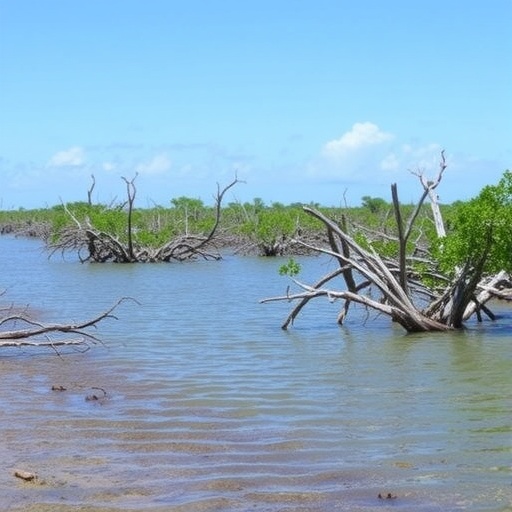In a groundbreaking new study published in the journal Cell Reports Sustainability, researchers from the UC Santa Cruz Center for Coastal Climate Resilience (CCCR), East Carolina University (ECU), and industry partner Moody’s RMS have quantified the monetary value of mangrove forests as natural storm surge defenders along Florida’s vulnerable coastline. Employing advanced catastrophe risk modeling frameworks traditionally used by the insurance industry, the team has produced the most comprehensive assessment to date of how mangroves influence flood depths and property loss dynamics during powerful hurricanes, including Hurricanes Irma (2017) and Ian (2022).
Mangrove ecosystems, with their intricate, aerial root systems adapted to saline environments, act as formidable natural buffers against storm surges by dissipating wave energy and reducing floodwater velocities. These coastal forests allow saltwater to be filtered into freshwater and foster essential ecological functions. Despite covering an estimated 600,000 acres in Florida’s southern coastal zone, mangroves have often been overlooked in economic valuations for flood risk management. This study addresses that critical gap by simulating the spatially variable protective effects of mangroves on specific coastal property portfolios.
The results are staggering: mangroves reduced combined surge and flood damage estimates by approximately $725 million during Hurricane Irma and by $4.1 billion during Hurricane Ian. Annually, for Collier County alone, the study predicts that mangroves contribute an approximate $67 million in avoided storm surge losses. These figures are grounded in sophisticated, industry-grade computational models that integrate hydrodynamic surge data with property vulnerability profiles, thereby providing stakeholder-relevant insights for insurance, urban planning, and conservation policies.
One of the most novel findings is the spatial heterogeneity in mangrove protection. While properties situated landward of mangrove belts consistently benefit from reduced surge depths and financial losses, those located seaward—directly in front of mangroves—sometimes experience elevated risks. This paradox arises from altered wave reflection and flow patterns where mangroves influence the physical oceanographic conditions in complex manners that may amplify localized flooding for some coastal frontiers. Therefore, risk assessments must consider this nuanced spatial variability rather than assuming uniform mangrove benefits.
The research harnessed state-of-the-art catastrophe risk models commonly used in the insurance industry, a first for ecological coastal defenses. Moody’s RMS provided essential modeling infrastructure, combining hydrodynamic simulation outputs with property-level exposure data to estimate the economic impact of storm surges with and without mangrove cover. This collaboration bridges natural science and risk finance, highlighting how incorporating ecosystem services into financial risk models can elevate ecosystem conservation as a tangible, economically defensible strategy.
Dr. Siddharth Narayan, the study’s lead author and a professor of coastal studies at ECU, emphasizes the real-world utility of these findings. Comparing the Florida mangrove results with previous findings in the northeastern US for salt marsh wetlands during Hurricane Sandy, Narayan stresses that nature-based solutions provide measurable reductions in property damage—between 14 to 30 percent in surge-induced loss due to mangrove presence in Florida. This quantification enables stakeholders from policymakers to insurers to recognize mangroves as cost-effective, scalable climate adaptation tools.
Florida’s coastal environment, characterized by sprawling expensive developments and increasing hurricane intensities, is particularly susceptible to surge-induced flood hazards. Mangroves play a pivotal ecological and physical role in this context, filtering pollutants, stabilizing sediments, and buffering storm impacts. However, this study underscores that preservation efforts must be strategic, taking into account where property developments occur relative to natural barriers. Developing in front of mangroves can undermine the very protection these forests offer, heightening risk exposure for storm impacts.
The study situates itself within a broader scientific discourse that increasingly recognizes the dual role of natural habitats as both ecological treasures and critical infrastructural assets. By translating the flood mitigation capacities of mangroves into dollar values understood by insurance and real estate markets, the research aims to steer funding and regulatory incentives toward mangrove conservation. This could have far-reaching implications for coastal resilience planning as sea level rise and storm frequency escalate under climate change.
Funding support from the Walton Family Foundation, the Herbert W. Hoover Foundation, AXA Research Fund, and the National Science Foundation enabled this interdisciplinary collaboration, bringing together experts in coastal ecology, risk modeling, and conservation. The multi-institutional team included prominent figures such as CCCR’s director Michael Beck, whose leadership emphasizes that valuation of ecosystem services is crucial because society protects what it values monetarily.
Expanding beyond Florida, the modeling framework developed offers a replicable blueprint for assessing mangrove benefits globally in tropical and subtropical coastlines. As more regions confront increasing exposure to severe tropical cyclones and their attendant flood risks, integrating these natural defenses into spatial planning and insurance underwriting can substantially reduce economic losses and safeguard vulnerable communities.
The study also serves as a cautionary message regarding the unintended consequences of coastal development in mangrove-rich environments. Urban and infrastructure projects located seaward of mangroves could disrupt natural flow regimes and diminish overall coastal resilience, emphasizing that future planning must be underpinned by robust geospatial risk analyses that consider ecosystem interactions with storm surge dynamics at a granular level.
In conclusion, this pioneering research bridges ecological science and financial risk analysis to demonstrate the immense, spatially diverse flood protection benefits of mangroves in Florida. It challenges traditional hard-engineered flood defenses by illustrating that natural ecosystems, when preserved and intelligently integrated into coastal management, can offer cost-effective and sustainable solutions against escalating climate threats. Mangroves are not merely biodiversity hotspots but indispensable frontline defenders that save billions of dollars in property losses during hurricanes, a true testament to the power of nature-based resilience.
Subject of Research: Not applicable
Article Title: The spatially variable effects of mangroves on flood depths and losses from storm surges in Florida
News Publication Date: 14-Oct-2025
Web References:
https://www.cell.com/cell-reports-sustainability/fulltext/S2949-7906(25)00227-7
References:
Narayan, S., Thomas, C.J., Nzerem, K., Matthewman, J., Shephard, C., Geselbracht, L., Beck, M.W. (2025). The spatially variable effects of mangroves on flood depths and losses from storm surges in Florida. Cell Reports Sustainability. DOI: 10.1016/j.crsus.2025.100531
Image Credits: Image by J. Kendall-Bar, UC Santa Cruz
Keywords: Climate change mitigation, Risk reduction




